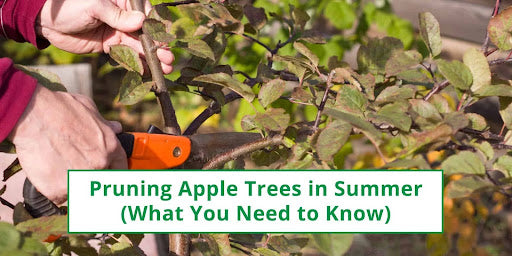Pruning an apple tree may sound like a chore, especially in summer, but the benefits make it more than worth it.
It controls growth, improves air and sunlight, enhances fruit quality, and makes picking easier.
However, there’s a right and wrong way to prune an apple tree. If done incorrectly, summer pruning can invite problems as well.
If you have questions about summer pruning an apple tree, you’re in the right place.
In this post, we’ll discuss the benefits of apple tree pruning, when and how to do it step-by-step, and other common questions.
Let’s dive in.
The Benefits of Pruning Apple Trees in Summer
Some people think you should prune your trees in winter only, when they’re asleep and bare. But summer pruning can be a game-changer for a tree’s health and your harvest.
Here are the benefits:
Keeps Wild Growth in Check
Apple trees can grow a little too much at times. During summer, you’ll notice water sprouts shooting upwards.
Pruning lets you slow this overgrowth down. And when you do that, the tree redirects its energy from leafy chaos to a more balanced growth.
Lets the Sunshine In
Shade isn’t good for the health of your apples. Less sunlight often leads to smaller, underdeveloped fruit. It can also cause fungal diseases like apple scab or powdery mildew.
So, prune that crowded canopy to let the sunlight reach the tree’s center. This also improves airflow, making it hard for pests and mold to appear.
Improves Fruit Size and Quality
When your apple tree doesn’t have to invest its energy into growing useless sprouts, it can give more support to what matters most: The apples!
Help your tree concentrate its nutrients on producing juicier, larger apples by pruning away excess growth like:
- Small shoots at the base (Suckers)
- Vertical shoots (Water sprouts)
In short, get fatter fruit by reducing the number of branches.
Reduces the Risk of Broken Branches
Summer apples can get heavy. If you let all the weight fall on weak or overcrowded branches, they may break off.
Broken branches can have multiple drawbacks. For instance, they tear the bark and leave the tree vulnerable to pests, rot, and diseases.
And, a broken limb may take years to fully recover, affecting your tree’s overall productivity in the future.
Pruning the tree before midsummer helps you lighten the load and prevent breakage.
Makes the Harvest Way Easier
A bunch of unnecessary branches don’t have to cover your ripe apples. Summer pruning makes your tree neat and more manageable.
Prune away those extra twigs, so you don’t have to climb awkwardly to get to your fruit.
When to Prune Apple Trees in Summer
Late June and early August are the best times to prune an apple tree.
By then, you’ll spot water sprouts, shoots that grow vertically. They don’t produce fruit and can burden your tree, making them a perfect target for pruning.
But, when not to prune an apple tree? During a heatwave or drought. These are tough times for your tree. Pruning can add more pressure.
Try pruning on a dry day. Wet conditions promote the spread of diseases through open cuts.
How to Prune Apple Trees in Summer (Step-by-Step)
If you’ve never pruned an apple tree before, don’t worry. You don’t have to be a professional for this. Summer pruning is more about maintenance than a makeover.
Here’s an actionable step-by-step guide.
Gather Your Tools
Start by gathering the tools you’ll need. Just a few basic ones will do:
- Hand Pruners: For small twigs and young shoots
- Loppers: For slightly thicker branches
- Pruning Saw: For removing large limbs
- Gardening Gloves: For your protection
- Step Ladder: For reaching higher spots (If you have a tall tree)
Important: Clean and disinfect your blades to avoid spreading diseases from one tree to another. Rubbing alcohol will work for disinfecting.
Remove Water Sprouts
Start with the skinny shoots that grow vertically from the stem and major branches. These are water sprouts. They don’t produce fruit; they just take up nutrients.
Cut them off at the base. The sooner you do that, the less you feed them.
Thin Out Crowded Areas
Step back and look for any crowded areas. You want to remove inward-growing (Toward the trunk) and overlapping branches.
Also, remove limbs that block sunlight from reaching the lower canopy. If two branches compete against each other for the same space, cut the less healthy one.
Remove Dead or Diseased Wood
Scan your tree for limbs that look dry, discolored, or brittle. Use your loppers or pruning saw to cut them until the healthy part appears.
To check if a piece of wood is dead or alive, gently scrape the bark with your fingernail. If it’s brown and dry, it’s dead. If it’s green, it’s alive.
Related: How to Prune Heavy Branches
Don’t Overdo It
When it comes to pruning apple trees in summer, less is more. This means making sure you’re not trimming too much of it.
Overdoing it can stress the tree and make it vulnerable to sunburn.
If you think there’s a lot of work, don’t try to tackle everything in one go. Divide the work over two seasons.
Frequently Asked Questions
Let’s address some frequently asked questions about pruning apple trees in summer.
Does Pruning Apple Trees Cause Problems?
Yes, but only if it’s done incorrectly or at the wrong time. For instance, pruning trees in extreme temperatures can weaken the tree and invite pests.
What Happens If You Prune Apple Trees in Summer?
Done correctly, summer pruning an apple tree:
- Helps shape the tree
- Encourages better fruit size and color
- Slows down unnecessary growth
However, avoid pruning too aggressively. It can lead to the tree growing even more water sprouts.
What Not to Do When Pruning Apple Trees?
Don’t prune your apple trees in extremely hot weather and wet conditions. Also, don’t cut them more than 20% at once.
Should You Cut the Top Off an Apple Tree?
Topping might seem like a fast way to shrink your tree, but it can leave it vulnerable to sunburn and disease. Instead, prune gently over time to decrease the height.
Conclusion
Pruning apple trees isn’t as complicated as it sounds. You just need the right tools, follow the right techniques, and pick the right time.
Things to remember:
- Pune between June and August
- Focus on water sprouts, dead wood, and crowded spots
- Don’t prune your tree more than 20% at once
- Avoid pruning in extreme hot and humid weather
Read More: Scissors Vs. Pruning Shears (Which One to Choose?)


